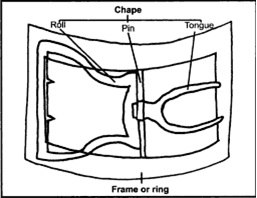 |
| Fragment of buckle frame found in our unit |
While doing archaeology, you never know what secrets the
ground might hold. For instance, yesterday, while excavating our unit, my unit
partner and I uncovered what appeared to be a rusty nail. When we are digging
in the layers believed to be undisturbed, we pedestal around artifacts to leave
them in situ until we map the unit. While
mapping, we noticed that what appeared to be a rusty, slightly bent nail was something
much more. The clinging dirt and small bits of corrosion were removed and an
ornate fragment of some variety of buckle. The decoration includes a small
heart motif with a "wrapped wire" molded design.
Now,
not knowing much about buckles, especially those from the 18th century and not
the belt variety from the 1980s with unicorns on them, I decided to do some
research. However, now I know more about them than I have ever dreamed, mainly
because I've never dreamed about knowing about buckles.
Most
people consider buckles' only use to be to secure belts. But, between the 17th
and 18th centuries, buckles had diverse roles. In addition to belts, buckles
were used on shoes, breeches, harnesses, stocks (a men's garment that consisted
of a piece of cloth wrapped around the neck and secured with a tie, or you
guessed it, a buckle), girdles (a women's fancy belt worn with fancy dresses),
hats, and with long boots (garter buckles), swords and spurs. They also had
varying levels of decoration, frequently based on function but also
socio-economic status. For instance, garter buckles are generally undecorated,
while girdle buckles tend to be the fanciest. Shoe buckles, however, can be a
simple rectangular frame, or a valuable, highly decorated gilded piece with
intricate scrollwork. Shoe buckles are often an indicator of socio-economic
status because of the high variation of ornamentation, though the presence or
lack of an elaborate specimen alone cannot be the sole deciding factor.
.jpg) |
| Anatomy of a buckle (Image from White, 2005) |
In
addition to function, buckles can vary greatly in material, from copper alloy,
to iron, pewter, and gilded or plated metals. They may also have inlays, such
as shell, ceramic, wood, precious or semi-precious stones, or "paste"
stones. Paste stones are false gemstones, similar to rhinestones, made out of
flint glass and high in lead content, and are often preferred for use in shoe
buckles, due to inexpensive pricing as well as ease of setting into the buckle.
Buckles
can also be used diagnostically for dating purposes, especially shoe buckles.
They generally were only in use between the late 1600s until the late 1700s and
early 1800s. Also, styles changed greatly in that time as well, with larger,
more ornamented shoe buckles being later than smaller, simpler ones. Decoration
can also play an important role in dating a specimen.
Diagnostically, certain
aspects of a buckle can be used to determine its function. Size and decoration
are important, but also aspects such as frame and chape (the interior part of a
buckle, see diagram) design are key elements to consider. For instance, the
frame of a shoe buckle will be more curved to fit the contours of the foot,
whereas a knee buckle, used to keep breeches tightly fitted to above or below
the knee, will be more flat. And, more visible buckles tend to be more highly
decorated, at least if socio-economic status allows for it-- so shoe, knee,
hat, and stock buckles are often those most highly ornate.
Our
fragment of a buckle frame seems to be from a shoe, based on its curvature as
well as size. While the fragment is only about 40mm long, it appears to have
had a height of around 45mm. The width is difficult to project, as not enough
of the fragment remains. From colour, patina, and weight, it seems to be made
of pewter, though closer analysis should be made. Interestingly, a nearly
identical fragment was found at Fort Michilimackinac, and was made of brass.
It's about the same length, except it broke off at a slightly higher point, and
bears the same decoration. The heart motif was important in Jesuit designs,
which could imply origins of this buckle.
In
summary, something as mundane as a fragment of a shoe buckle can tell us a lot
about not only the particular area in which it was excavated, but also about
how people lived at Fort St. Joseph. Even at a post in the wilds of Michigan,
ornamentation and personal decoration seem to have still been important in everyday
life.
.jpg) |
| Fragment of buckle frame found at Fort Michilimackinac (Image from Stone, 1974) |
Sources: Kerr, Ian B.
(2012), "An Analysis of Personal Adornment at Fort St. Joseph (20BE23), An
Eighteenth-Century French Trading Post in Southwest Michigan". Master's
Thesis. Western Michigan University, Department of Anthropology.
Stone, Lyle M.,
(1974). Fort Michilimackinac 1715-1781:
An Archaeological Perspective on the Revolutionary Frontier. Publications
of the Museum, Michigan State University
White, Carolyn L.,
(2005). American Artifacts of Personal
Adornment 1680-1820: A Guide to Identification and Interpretation. Altamira
Press.






